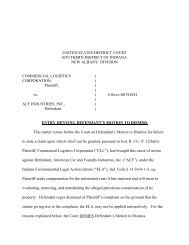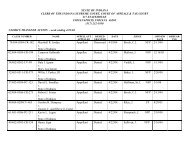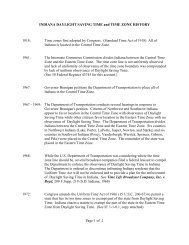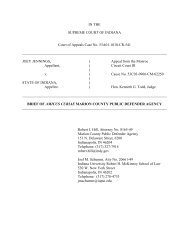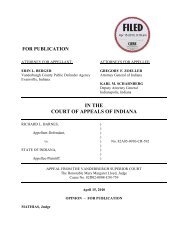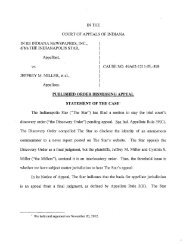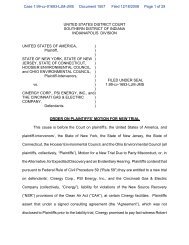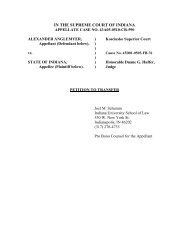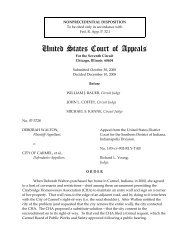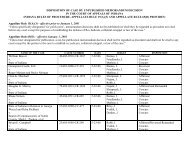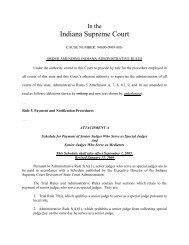Estate of Tammy Jean Vandam, et al. v. Mitchell Daniels, et al
Estate of Tammy Jean Vandam, et al. v. Mitchell Daniels, et al
Estate of Tammy Jean Vandam, et al. v. Mitchell Daniels, et al
Create successful ePaper yourself
Turn your PDF publications into a flip-book with our unique Google optimized e-Paper software.
Case 1:11-cv-01302-SEB-MJD Document 40 Filed 11/23/11 Page 1 <strong>of</strong> 28 PageID #: 360<br />
ESTATE OF TAMMY JEAN VANDAM,<br />
by its duly appointed Speci<strong>al</strong> Administrator,<br />
HORIZON TRUST & INVESTMENT<br />
MANAGEMENT, N.A., JANEEN BETH<br />
URSCHEL, ESTATE OF CHRISTINA<br />
SANTIAGO, by its duly appointed<br />
Administratrix, ALISHA BRENNON,<br />
ALISHA BRENNON, ESTATE OF ALINA<br />
R. BIGJOHNY, by its duly appointed<br />
Speci<strong>al</strong> Administratrix, POLLY A.<br />
BIGJOHNY, and TAMARA PORTER, on<br />
beh<strong>al</strong>f <strong>of</strong> themselves and those similarly<br />
situated,<br />
Plaintiffs,<br />
vs.<br />
MITCHELL E. DANIELS, JR., in his<br />
<strong>of</strong>fici<strong>al</strong> capacity as Governor <strong>of</strong> the State <strong>of</strong><br />
Indiana, and GREGORY ZOELLER, in his<br />
<strong>of</strong>fici<strong>al</strong> capacity as Attorney Gener<strong>al</strong> <strong>of</strong> the<br />
State <strong>of</strong> Indiana,<br />
Defendants,<br />
vs.<br />
ROELAND POLET, JAYMIE POLET, J.P.,<br />
a minor, TRACY L. GREEN, and JILL<br />
MANDEL POLET,<br />
Intervenor Plaintiffs.<br />
UNITED STATES DISTRICT COURT<br />
SOUTHERN DISTRICT OF INDIANA<br />
INDIANAPOLIS DIVISION<br />
)<br />
)<br />
)<br />
)<br />
)<br />
)<br />
)<br />
)<br />
)<br />
)<br />
)<br />
)<br />
)<br />
)<br />
)<br />
) 1:11-cv-01302-SEB-MJD<br />
)<br />
)<br />
)<br />
)<br />
)<br />
)<br />
)<br />
)<br />
)<br />
)<br />
)<br />
)<br />
)<br />
ENTRY ON PENDING MOTIONS<br />
This cause is now before the Court on Plaintiffs’ Emergency Motion to Certify<br />
Class [Dock<strong>et</strong> No. 9], filed October 11, 2011, pursuant to Feder<strong>al</strong> Rule <strong>of</strong> Civil Procedure<br />
23; Plaintiffs’ Motion for Preliminary Injunction [Dock<strong>et</strong> No. 12], filed October 13, 2011,
Case 1:11-cv-01302-SEB-MJD Document 40 Filed 11/23/11 Page 2 <strong>of</strong> 28 PageID #: 361<br />
pursuant to Feder<strong>al</strong> Rule <strong>of</strong> Civil Procedure 65; and Plaintiffs’ Emergency Motion for<br />
Discovery [Dock<strong>et</strong> No. 18], filed October 14, 2011, pursuant to Feder<strong>al</strong> Rule <strong>of</strong> Civil<br />
Procedure 34. 1<br />
Plaintiffs, <strong>Estate</strong> <strong>of</strong> <strong>Tammy</strong> <strong>Jean</strong> VanDam <strong>et</strong> <strong>al</strong>., filed this action pursuant<br />
to 42 U.S.C. § 1983, claiming that Defendants, <strong>Mitchell</strong> E. <strong>Daniels</strong>, Jr. and Gregory<br />
Zoeller, violated their rights to due process and equ<strong>al</strong> protection protected by the<br />
Fourteenth Amendment to the United States Constitution. Further, Plaintiffs <strong>al</strong>lege that<br />
certain damages caps established by Indiana Code § 34-13-3-4––a portion <strong>of</strong> the Indiana<br />
Tort Claims Act––violate these Fourteenth Amendment rights as well as Article 1,<br />
Section 12 <strong>of</strong> the Indiana Constitution. 2<br />
The Court conducted a hearing on October 24, 2011 [Dock<strong>et</strong> No. 30], at which<br />
time we d<strong>et</strong>ermined that class certification was not immediately necessary. Having<br />
reviewed the parties’ subsequent briefing, and for other reasons d<strong>et</strong>ailed in this entry, the<br />
Court now GRANTS Plaintiffs’ Motion to Certify Class, but only with respect to the<br />
feder<strong>al</strong> constitution<strong>al</strong> issue. Addition<strong>al</strong>ly, we DENY Plaintiffs’ Motion for Preliminary<br />
Injunction, and we DENY Plaintiffs’ Emergency Motion for Discovery.<br />
Background<br />
1 Because the parties have compl<strong>et</strong>ed and submitted their briefs, this entry disposes <strong>of</strong><br />
Plaintiffs’ Motion for Expedited Briefing Schedule [Dock<strong>et</strong> No. 11], filed October 11, 2011.<br />
Plaintiffs’ Motion for Or<strong>al</strong> Argument or Hearing on Plaintiffs’ Motion to Certify Class Action<br />
[Dock<strong>et</strong> No. 34], filed November 7, 2011, is similarly moot because <strong>of</strong> the Court’s October 24,<br />
2011 hearing and our present decision on the other pending motions.<br />
2 Article 1, Section 12 <strong>of</strong> the Indiana Constitution provides that “[a]ll courts sh<strong>al</strong>l be open;<br />
and every person, for injury done to him in his person, property, or reputation, sh<strong>al</strong>l have remedy<br />
by due course <strong>of</strong> law. Justice sh<strong>al</strong>l be administered freely, and without purchase; compl<strong>et</strong>ely,<br />
and without deni<strong>al</strong>; speedily, and without deni<strong>al</strong>.”
Case 1:11-cv-01302-SEB-MJD Document 40 Filed 11/23/11 Page 3 <strong>of</strong> 28 PageID #: 362<br />
I. The Stage Collapse and the Parties<br />
The horrific facts underlying this litigation sadly have become uns<strong>et</strong>tlingly familiar<br />
to <strong>al</strong>most everyone across Indiana, indeed, throughout the country. Each August, the<br />
Indiana State Fair presents a series <strong>of</strong> concerts at the Hoosier Lottery Grandstand, located<br />
within the Indiana State Fairgrounds in Indianapolis, Indiana. Sugarland, a popular<br />
country music duo, was scheduled to take the stage for one such concert on August 13,<br />
2011. Regr<strong>et</strong>tably, the show never began that night, as what initi<strong>al</strong>ly looked like<br />
inclement weather quickly esc<strong>al</strong>ated into tragedy. Moments before the concert was s<strong>et</strong> to<br />
begin but after the grandstands and adjoining seating areas had filled with eager fans,<br />
strong winds swept through and toppled the stage’s overhead rigging and lighting system;<br />
these structures collapsed directly into the grandstand and onto assembled audience<br />
members. This tragic event, to which we hereinafter refer as the “Stage Collapse,”<br />
proximately resulted in seven lost lives and serious injuries to numerous other persons.<br />
All <strong>of</strong> the named Plaintiffs in this action were present in the Hoosier Lottery<br />
Grandstand on August 13, 2011 and <strong>al</strong>lege as follows regarding their injuries either<br />
directly or proximately caused by the Stage Collapse:<br />
<strong>Tammy</strong> <strong>Jean</strong> VanDam, whose interests are represented by her estate, died <strong>al</strong>most<br />
instantly in the Stage Collapse. Second Am. Compl. 11. Christina Santiago and Alina<br />
Bigjohny, <strong>al</strong>so represented by their estates, both died from crushing injuries sustained that<br />
night. Id. 13, 15. Janeen “B<strong>et</strong>h” Urschel had her m<strong>et</strong>atars<strong>al</strong> ph<strong>al</strong>anges amputated and<br />
suffered “significant person<strong>al</strong> physic<strong>al</strong> injury”––namely, a broken clavicle and crushed<br />
right foot––due to the Stage Collapse. Id. 12. Alisha Brennon suffered a brain injury
Case 1:11-cv-01302-SEB-MJD Document 40 Filed 11/23/11 Page 4 <strong>of</strong> 28 PageID #: 363<br />
and fractures to her leg, face, ribs, and vertebrae. Id. 14. Addition<strong>al</strong>ly, Ms. Urschel and<br />
Ms. Brennon both claim loss <strong>of</strong> consortium because their partners––Ms. VanDam and<br />
Ms. Santiago, respectively––died as a result <strong>of</strong> the Stage Collapse. Tamara Porter <strong>al</strong>leges<br />
physic<strong>al</strong> impact during the Stage Collapse and “extreme psychologic<strong>al</strong> and emotion<strong>al</strong><br />
trauma as a result.” Id. 16.<br />
At <strong>al</strong>l times relevant to this lawsuit, Defendant <strong>Mitchell</strong> E. <strong>Daniels</strong>, Jr. was the<br />
Governor <strong>of</strong> the State <strong>of</strong> Indiana. Section 34-13-3-14 <strong>of</strong> the Indiana Code, a provision <strong>of</strong><br />
the Indiana Tort Claims Act, vests in him the power to “compromise or s<strong>et</strong>tle a claim or<br />
suit brought against the state or its employees” in tort. Ind. Code § 34-13-3-14. Plaintiffs<br />
have brought suit against him and Defendant Gregory Zoeller, the current Attorney<br />
Gener<strong>al</strong> for the State <strong>of</strong> Indiana (“Attorney Gener<strong>al</strong>”), both in their <strong>of</strong>fici<strong>al</strong> capacities.<br />
II. The Indiana Tort Claims Act<br />
Pursuant to the Indiana Tort Claims Act, an individu<strong>al</strong> wishing to pursue a tortbased<br />
action against the State <strong>of</strong> Indiana must first file a notice <strong>of</strong> his or her tort claim<br />
with the Attorney Gener<strong>al</strong> or other state agency involved. Ind. Code § 34-13-3-6(a). The<br />
purpose <strong>of</strong> requiring the submission <strong>of</strong> a notice <strong>of</strong> tort claim is to “inform state <strong>of</strong>fici<strong>al</strong>s<br />
with reasonable certainty <strong>of</strong> the accident or incident and surrounding circumstances so<br />
that the state may investigate, d<strong>et</strong>ermine its possible liability, and prepare a defense to the<br />
claim.” Rick<strong>et</strong>ts v. State, 720 N.E.2d 1244, 1246 (Ind. Ct. App. 1999). The appropriate<br />
government<strong>al</strong> entity then has nin<strong>et</strong>y (90) days to respond in writing to the notice,<br />
informing the claimant <strong>of</strong> its approv<strong>al</strong> or deni<strong>al</strong> <strong>of</strong> the claim. Ind. Code § 34-13-3-11.<br />
No person may bring such action in a court <strong>of</strong> law until his or her tort claim has been
Case 1:11-cv-01302-SEB-MJD Document 40 Filed 11/23/11 Page 5 <strong>of</strong> 28 PageID #: 364<br />
denied in whole or in part. Id. § 34-13-3-13.<br />
One who files a notice <strong>of</strong> tort claim with the Attorney Gener<strong>al</strong> must do so within<br />
the statutorily-s<strong>et</strong> period <strong>of</strong> two hundred seventy (270) days after the triggering event.<br />
The form for such notice is provided by the Attorney Gener<strong>al</strong>; it “must specify: (1) the<br />
information required; and (2) the period <strong>of</strong> time that a potenti<strong>al</strong> claimant has to file a<br />
claim.” Ind. Code § 34-14-13-6(b); see <strong>al</strong>so id. § 4-22-2 (rule adopted under the Indiana<br />
Code requiring the Attorney Gener<strong>al</strong> to prescribe claim forms). However, the Indiana<br />
Code does not require the Attorney Gener<strong>al</strong> to declare on this form that the filing deadline<br />
is 270 days. Moreover, it does not preclude the government<strong>al</strong> entity from s<strong>et</strong>ting a<br />
different deadline <strong>al</strong>tog<strong>et</strong>her. See id. § 34-14-13-6(b).<br />
Following the Stage Collapse, the Attorney Gener<strong>al</strong> created the Indiana State Fair<br />
Tort Claim Form (the “Claim Form”) and posted the document publicly on its website<br />
<strong>al</strong>ong with related news releases focusing attention on the process. The Claim Form<br />
requests the following information from each claimant or his or her representative: (1)<br />
basic contact information; (2) the length <strong>of</strong> any Stage Collapse-related hospit<strong>al</strong>ization<br />
(with supporting documentation); (3) wh<strong>et</strong>her the claimant died as a result <strong>of</strong> the Stage<br />
Collapse; (4) demographic information, including number <strong>of</strong> dependents, marit<strong>al</strong> status,<br />
head <strong>of</strong> household status, level <strong>of</strong> education, and income range; (5) the length <strong>of</strong> any<br />
Stage Collapse-related absence(s) from work; and (6) a description <strong>of</strong> the nature and<br />
extent <strong>of</strong> the claimant’s injuries and their actu<strong>al</strong> or reasonably expected impact on the
Case 1:11-cv-01302-SEB-MJD Document 40 Filed 11/23/11 Page 6 <strong>of</strong> 28 PageID #: 365<br />
claimant. 3<br />
Defendants required <strong>al</strong>l Stage Collapse claimants to submit the Claim Form by<br />
November 1, 2011. Second Am. Compl. 33.<br />
Though suits against government<strong>al</strong> entities have tradition<strong>al</strong>ly been limited by<br />
principles <strong>of</strong> sovereign immunity, the Indiana Gener<strong>al</strong> Assembly has “increasingly<br />
<strong>al</strong>lowed the government to be sued for wrongdoing.” Brownsburg Cmty. Sch. Corp. v.<br />
Natare Corp., 824 N.E.2d 336, 345 (Ind. 2005). In 1974, soon after the Indiana Supreme<br />
Court’s abrogation <strong>of</strong> sovereign immunity in Campbell v. State, 284 N.E.2d 733, 736-37<br />
(Ind. 1972), the state legislature enacted the Indiana Tort Claims Act, Ind. Code § 34-13-<br />
3-1 <strong>et</strong> seq. The statute provides, inter <strong>al</strong>ia, a list <strong>of</strong> government<strong>al</strong> activities that the<br />
legislature has immunized from tort liability. See id. § 34-13-3-3. In situations where, as<br />
is the case with the Stage Collapse, government<strong>al</strong> actors are not excluded from liability, 4<br />
Section 34-13-3-4 <strong>of</strong> the statute limits the State’s liability as follows:<br />
The combined aggregate liability <strong>of</strong> <strong>al</strong>l government<strong>al</strong> entities and <strong>of</strong> <strong>al</strong>l public<br />
employees, acting within the scope <strong>of</strong> their employment . . . does not exceed:<br />
(1) for injury to or death <strong>of</strong> one (1) person in any one (1) occurrence:<br />
(c) seven hundred thousand dollars ($700,000) for a cause <strong>of</strong> action<br />
that accrues on or after January 1, 2008; and<br />
(2) for injury to or death <strong>of</strong> <strong>al</strong>l persons in that occurrence, five million<br />
dollars ($5,000,000).<br />
Id. § 34-13-3-4(a). Defendants have publicly announced their intention to disburse the<br />
full $5,000,000 available for Stage Collapse victims, but no more than that amount.<br />
3 OFFICE OF IND. ATT’Y GEN., INDIANA STATE FAIR TORT CLAIM FORM: PHYSICAL<br />
INJURY OR DEATH FROM INCIDENT ON AUGUST 13, 2011 (Sept. 2011), available at<br />
http://www.in.gov/attorneygener<strong>al</strong>/files/Indiana_State_Fair_Tort_Claim_Form.pdf.<br />
4 The Stage Collapse does not f<strong>al</strong>l within any <strong>of</strong> the enumerated losses for which “[a]<br />
government<strong>al</strong> entity or an employee acting within the scope <strong>of</strong> the employee’s employment is<br />
not liable.” See Ind. Code § 34-13-3-3.
Case 1:11-cv-01302-SEB-MJD Document 40 Filed 11/23/11 Page 7 <strong>of</strong> 28 PageID #: 366<br />
Second Am. Compl. 33; Defs.’ Prelim. Resp. Br. at 3. Although we are informed that<br />
the distribution <strong>of</strong> this fund has not y<strong>et</strong> commenced, it is Defendants’ position that, when<br />
and if any individu<strong>al</strong> s<strong>et</strong>tles a claim by accepting payment from this fund, it “will release<br />
the State . . . from <strong>al</strong>l liability.” Id. 36.<br />
A related fund, <strong>al</strong>so supervised by the State, is the State Fair Relief Fund,<br />
consisting <strong>of</strong> <strong>al</strong>l the donations voluntarily given by private individu<strong>al</strong>s to assist the<br />
victims with their medic<strong>al</strong> losses. This fund was established by the State Fair<br />
Commission in response to the outpouring <strong>of</strong> concern and support for the victims and<br />
their families. Second Am. Compl. 34. The distribution system for this voluntary<br />
repository sorts claimants according to “(a) death cases, (b) hospit<strong>al</strong>ization for 10 or more<br />
days, (c) hospit<strong>al</strong>ization for 4-9 days, and (d) hospit<strong>al</strong>ization for 1-3 days, with claimants<br />
receiving separate amounts . . . depending solely upon the category into which they fit.”<br />
Id. The Attorney Gener<strong>al</strong> avers that the State has “had nothing to do with the distribution<br />
<strong>of</strong> the charitable donations,” and Plaintiffs present no evidence as to the distribution<br />
procedures or the individu<strong>al</strong>s who received money from this fund. Defs.’ Resp. Br. at 3-<br />
4.<br />
Leg<strong>al</strong> An<strong>al</strong>ysis<br />
I. Motion for Class Certification<br />
A. Standard <strong>of</strong> Review<br />
When d<strong>et</strong>ermining wh<strong>et</strong>her certification <strong>of</strong> a class action lawsuit is appropriate, a<br />
district court has broad discr<strong>et</strong>ion. Chavez v. Ill. State Police, 251 F.3d 612, 629 (7th Cir.
Case 1:11-cv-01302-SEB-MJD Document 40 Filed 11/23/11 Page 8 <strong>of</strong> 28 PageID #: 367<br />
2001). It is well-s<strong>et</strong>tled Supreme Court precedent that “[c]lass relief is ‘peculiarly<br />
appropriate’ when the ‘issues involved are common to the class as a whole’ and when<br />
they ‘turn on questions <strong>of</strong> law applicable in a manner to each member <strong>of</strong> the class.’” Gen.<br />
Tel. Co. <strong>of</strong> Sw. v. F<strong>al</strong>con, 457 U.S. 147, 155 (1982) (quoting C<strong>al</strong>ifano v. Yamasaki, 442<br />
U.S. 682, 701 (1979)).<br />
Class action lawsuits are governed by Feder<strong>al</strong> Rule <strong>of</strong> Civil Procedure 23. A party<br />
seeking class certification under this rule bears the burden <strong>of</strong> demonstrating that<br />
certification is appropriate. R<strong>et</strong>ired Chi. Police Ass’n v. City <strong>of</strong> Chi., 7 F.3d 584, 596 (7th<br />
Cir. 1993). Rule 23 prescribes a two-step an<strong>al</strong>ysis to make this d<strong>et</strong>ermination. First, a<br />
plaintiff must satisfy <strong>al</strong>l four threshold requirements <strong>of</strong> Rule 23(a): numerosity,<br />
common<strong>al</strong>ity, typic<strong>al</strong>ity, and adequacy <strong>of</strong> representation. Spano v. Boeing Co., 633 F.3d<br />
574, 583 (7th Cir. 2011). These elements are a prerequisite to certification; failure to<br />
me<strong>et</strong> any <strong>of</strong> them precludes class certification. R<strong>et</strong>ired Chi. Police Ass’n, 7 F.3d at 596.<br />
If a plaintiff succeeds with respect to these elements, he must then satisfy Rule 23’s other<br />
requirement: showing that the circumstances <strong>of</strong> the case place it within one <strong>of</strong> Rule<br />
23(b)’s three “types” <strong>of</strong> class actions. Spano, 633 F.3d at 582. A district court’s decision<br />
as to the representative plaintiffs’ satisfaction <strong>of</strong> the Rule 23 prerequisites may only be s<strong>et</strong><br />
aside on appe<strong>al</strong> for an abuse <strong>of</strong> discr<strong>et</strong>ion. De La Fuente v. Stokely-Van Camp, Inc., 713<br />
F.2d 225, 232 (7th Cir. 1983).<br />
Here, Plaintiffs seek to certify their class under Feder<strong>al</strong> Rule <strong>of</strong> Civil Procedure<br />
23(a) and either Rule 23(b)(1) or 23(b)(2); they <strong>al</strong>so request that the Court designate them
Case 1:11-cv-01302-SEB-MJD Document 40 Filed 11/23/11 Page 9 <strong>of</strong> 28 PageID #: 368<br />
as class representatives and their counsel as class counsel. Defendants oppose class<br />
certification, arguing that Plaintiffs have failed to present facts establishing any <strong>of</strong> the<br />
Rule 23(a) certification prerequisites. In Defendants’ view, the participation <strong>of</strong> the<br />
Intervenor Plaintiffs (“Intervenors”) in this lawsuit, who are a group <strong>of</strong> claimants separate<br />
from but in addition to the putative class Plaintiffs, makes class certification even more<br />
inappropriate. Because the Intervenors are eager to s<strong>et</strong>tle their claims, Defendants<br />
contend that “certifying a class and imposing counsel on claimants who have counsel<br />
working for them . . . would be unjust and unwise.” Defs.’ Resp. Br. at 6.<br />
Plaintiffs seek to certify a class composed <strong>of</strong> the following individu<strong>al</strong>s:<br />
(a) the estates and person<strong>al</strong> representatives <strong>of</strong> <strong>al</strong>l those who died as a proximate<br />
result <strong>of</strong> the Stage Collapse;<br />
(b) <strong>al</strong>l persons who sustained physic<strong>al</strong> injury as a proximate result <strong>of</strong> the Stage<br />
Collapse; and<br />
(c) <strong>al</strong>l persons who sustained physic<strong>al</strong> impact in the Stage Collapse and suffered<br />
severe emotion<strong>al</strong> distress as a proximate result <strong>of</strong> the Stage Collapse.<br />
Second Am. Compl. 20. They maintain that “[w]hile the injuries may vary in severity,<br />
the cause <strong>of</strong> them is common and the theory <strong>of</strong> liability against the State will be uniform<br />
in nature.” Pls.’ Mot. for Class Cert. 4. In their Reply Brief, they specific<strong>al</strong>ly request<br />
class certification on a limited fund basis under Rule 23(b)(1)(B). Pls.’ Reply Br. at 9.<br />
B. Class Certification Criteria<br />
We next address the four criteria <strong>of</strong> class certification s<strong>et</strong> out in Rule 23(a):<br />
Numerosity. The Feder<strong>al</strong> Rules <strong>of</strong> Civil Procedure require that the class be so
Case 1:11-cv-01302-SEB-MJD Document 40 Filed 11/23/11 Page 10 <strong>of</strong> 28 PageID #: 369<br />
large as to render joinder <strong>of</strong> <strong>al</strong>l parties impracticable. Fed. R. Civ. P. 23(a)(1). Although<br />
no fixed numerosity rule exists and “no magic number satisfies this element,” id., the<br />
court must consider factors such as class size, ease <strong>of</strong> identifying members, geographic<br />
dispersion <strong>of</strong> members, and the magnitude <strong>of</strong> individu<strong>al</strong> claims. Young v. Magnequench<br />
Int’l, Inc., 188 F.R.D. 504, 506 (S.D. Ind. 1999). The court <strong>al</strong>so “considers judici<strong>al</strong><br />
economy and the ability <strong>of</strong> class members to institute individu<strong>al</strong> suits.” Schmitt v. United<br />
States, 203 F.R.D. 387, 401 (S.D. Ind. 2001) (citation omitted).<br />
In the instant litigation, Plaintiffs <strong>al</strong>lege––and Defendants do not contest––that the<br />
putative class numbers in the vicinity <strong>of</strong> one hundred (100) persons. Second Am. Compl.<br />
29. Such a class is not remarkably large; nevertheless, it appears to be sufficient.<br />
Schmitt, 203 F.R.D. at 401 (finding that a class <strong>of</strong> “approximately 100 to 120 members”<br />
satisfied Rule 23(a)(1)); see <strong>al</strong>so Cox v. Am. Cast Iron Pipe Co., 784 F.2d 1546, 1553<br />
(11th Cir. 1986) (concluding that “gener<strong>al</strong>ly . . . more than forty [is] adequate”). Further,<br />
because Plaintiffs have gathered some data about the proposed class via the submitted<br />
Claim Forms, we are persuaded that they are not merely speculating about this group’s<br />
size or geographic dispersion. They have identified many class members by name in their<br />
Second Amended Complaint and need not show an exact number <strong>of</strong> individu<strong>al</strong>s who are<br />
within the class to succeed on this prong. Second Am. Compl. 29; see Blanford v. St.<br />
Vincent Hosp. & He<strong>al</strong>th Care Ctr., Inc., No. 1:08-cv-1094-DFH-TAB, 2009 WL500527,<br />
at *6 (S.D. Ind. Feb. 27, 2009). Moreover, the Court finds that <strong>al</strong>though class members<br />
could institute individu<strong>al</strong> claims, joinder would be either “extremely difficult or
Case 1:11-cv-01302-SEB-MJD Document 40 Filed 11/23/11 Page 11 <strong>of</strong> 28 PageID #: 370<br />
inconvenient.” Evans v. Evans, 818 F. Supp. 1215, 1219 (N.D. Ind. 1993). Therefore, we<br />
find that Plantiffs have satisfied the numerosity requirement<br />
Common<strong>al</strong>ity. The next requirement for class certification is that the class present<br />
common questions <strong>of</strong> law or fact. Fed. R. Civ. P. 23(a)(2). “A common nucleus <strong>of</strong><br />
operative fact is usu<strong>al</strong>ly enough to satisfy the common<strong>al</strong>ity requirement <strong>of</strong> Rule 23(a)(2).”<br />
Keele v. Wexler, 149 F.3d 589, 594 (7th Cir. 1998) (quoting Rosario v. Livaditis, 963<br />
F.2d 1013, 1018 (7th Cir. 1992)). “Common nuclei <strong>of</strong> fact are typic<strong>al</strong>ly manifest where .<br />
. . the defendants have engaged in standardized conduct towards members <strong>of</strong> the proposed<br />
class.” Keele, 149 F.3d at 594. Plaintiffs <strong>al</strong>lege that Defendants have engaged in<br />
standardized conduct in sever<strong>al</strong> ways: “arbitrarily and capriciously attempt[ing] to compel<br />
s<strong>et</strong>tlement <strong>of</strong> claims”; “resolv[ing] claims . . . at the expense <strong>of</strong> the class as a whole”;<br />
preparing to pay claims up to the statutory damages cap <strong>of</strong> $5,000,000; and denying<br />
claimants access to the courts. Second Am. Compl. 57, 60, 64, 69.<br />
Because any well-crafted class action complaint raises common questions, the<br />
Supreme Court has acknowledged that Rule 23(a)(2) is <strong>of</strong>ten misread. In the recent<br />
decision in W<strong>al</strong>-Mart Stores, Inc. v. Dukes, 131 S. Ct. 2541 (2011), the Supreme Court<br />
stated that <strong>al</strong>though common<strong>al</strong>ity requires plaintiffs to “demonstrate that the class<br />
members have suffered the same injury,” their claims “must depend on a common<br />
contention . . . <strong>of</strong> such a nature that it is capable <strong>of</strong> classwide resolution––which means<br />
that d<strong>et</strong>ermination . . . will resolve an issue that is centr<strong>al</strong> to the v<strong>al</strong>idity <strong>of</strong> each one <strong>of</strong> the<br />
claims in one stroke.” Id. at 2551 (intern<strong>al</strong> quotation and citation omitted). The Court
Case 1:11-cv-01302-SEB-MJD Document 40 Filed 11/23/11 Page 12 <strong>of</strong> 28 PageID #: 371<br />
concluded that what is most relevant to class certification “is not the raising <strong>of</strong> common<br />
‘questions’ . . . but, rather the capacity <strong>of</strong> a classwide proceeding to generate common<br />
answers apt to drive the resolution <strong>of</strong> the litigation. Dissimilarities within the proposed<br />
class are what have the potenti<strong>al</strong> to impede the generation <strong>of</strong> common answers.” Id.<br />
(quoting Richard Nagareda, Class Certification in the Age <strong>of</strong> Aggregate Pro<strong>of</strong>, 84 N.Y.U.<br />
L. REV. 97, 132 (2009)).<br />
Defendants here argue that there is no evidence <strong>of</strong> common<strong>al</strong>ity because “[t]here<br />
are necessarily intra-class conflicts” permeating this case. Defs.’ Resp. Br. at 2. Stated<br />
otherwise, Defendants posit that the existence <strong>of</strong> a limited fund pits claimants against one<br />
another. Addition<strong>al</strong>ly, Defendants contend that Intervenors’ willingness to negotiate with<br />
the Attorney Gener<strong>al</strong> belies Plaintiffs’ <strong>al</strong>legations <strong>of</strong> common questions <strong>of</strong> law or fact.<br />
Id.<br />
We agree with Defendants that there is no common<strong>al</strong>ity with respect to the<br />
claimants’ interests in receiving their share <strong>of</strong> the public fund. The same is true for<br />
declaring “Defendants’ actions” unconstitution<strong>al</strong>, as Plaintiffs have no facts to<br />
demonstrate what Defendants have actu<strong>al</strong>ly done or, for that matter, intend to do.<br />
However, as long as a single issue is common to <strong>al</strong>l class members, “[n]ot <strong>al</strong>l factu<strong>al</strong> or<br />
leg<strong>al</strong> questions raised in the lawsuit need to be common.” Does v. City <strong>of</strong> Indianapolis,<br />
No. 1:06-cv-865-RLY-WTL, 2006 WL3365672, at *3 (S.D. Ind. Nov. 20, 2006) (quoting<br />
Riordan v. Smith Barney, 113 F.R.D. 60, 63 (N.D. Ill. 1986)). The Seventh Circuit has<br />
previously held that factu<strong>al</strong> variations among putative class members’ <strong>al</strong>legations do not
Case 1:11-cv-01302-SEB-MJD Document 40 Filed 11/23/11 Page 13 <strong>of</strong> 28 PageID #: 372<br />
automatic<strong>al</strong>ly defeat class certification. Keele, 149 F.3d 589; Patterson v. Gen. Motors<br />
Corp., 631 F.2d 476, 481 (7th Cir. 1980). Therefore, if a class claim could arise out <strong>of</strong><br />
the same leg<strong>al</strong> or remedi<strong>al</strong> theory, we may find that common<strong>al</strong>ity exists on a limited<br />
basis. Patterson, 631 F.3d at 481.<br />
Here, we find that, for purposes <strong>of</strong> d<strong>et</strong>ermining the issue <strong>of</strong> wh<strong>et</strong>her Indiana Code<br />
§ 34-13-3-4 violates the Due Process and Equ<strong>al</strong> Protection Clauses <strong>of</strong> the Fourteenth<br />
Amendment to the U.S. Constitution, Plaintiffs have satisfied Rule 23(a)(2)’s<br />
common<strong>al</strong>ity requirement. Importantly, however, we find no common<strong>al</strong>ity among the<br />
proposed class members regarding access to the courts under the Indiana Constitution or<br />
any issues involving distribution <strong>of</strong> the public fund.<br />
Typic<strong>al</strong>ity. Rule 23(a) <strong>al</strong>so requires the representative parties’ claims or defenses<br />
to be “typic<strong>al</strong> <strong>of</strong> the claims or defenses <strong>of</strong> the class.” Fed. R. Civ. P. 23(a)(3). The<br />
typic<strong>al</strong>ity prerequisite is m<strong>et</strong> if the named plaintiffs’ claims “arise[] from the same . . .<br />
practice or course <strong>of</strong> conduct that gives rise to the claims <strong>of</strong> other class members and . . .<br />
are based on the same leg<strong>al</strong> theory.” Muro v. Targ<strong>et</strong> Corp., 580 F.3d 485, 492 (7th Cir.<br />
2009) (quoting De La Fuente, 713 F.2d at 232). Although the named plaintiffs’ claims<br />
need not be identic<strong>al</strong> to <strong>al</strong>l class members’ claims, they must be “substanti<strong>al</strong>ly similar” so<br />
that the interests <strong>of</strong> the class and its representatives may be <strong>al</strong>igned. In re Ready-Mixed<br />
Concr<strong>et</strong>e Antitrust Litig., 261 F.R.D. 154, 168 (S.D. Ind. 2009).<br />
Consistent with our assessment above <strong>of</strong> the named Plaintiffs’ common<strong>al</strong>ity, we<br />
hold that the named Plaintiffs’ claims are not “substanti<strong>al</strong>ly similar” for the bulk <strong>of</strong> this
Case 1:11-cv-01302-SEB-MJD Document 40 Filed 11/23/11 Page 14 <strong>of</strong> 28 PageID #: 373<br />
lawsuit. We believe Defendants summed up the situation best by their statement that<br />
“[t]he interveners want their money now, and delaying payment harms them.” Defs.’<br />
Resp. Br. at 5. Indeed, as far as we can tell, only the six named Plaintiffs seek to enjoin<br />
the distribution <strong>of</strong> the public Stage Collapse fund. We are aware <strong>of</strong> no other claimants,<br />
save these six named individu<strong>al</strong>s, who prefer to litigate rather than negotiate with the<br />
Attorney Gener<strong>al</strong>. We are thus persuaded that typic<strong>al</strong>ity is satisfied only for the limited<br />
purpose <strong>of</strong> d<strong>et</strong>ermining the constitution<strong>al</strong>ity <strong>of</strong> Indiana’s damages cap for tort claims.<br />
Adequacy <strong>of</strong> Representation. Rule 23(a)’s fourth prerequisite requires a showing<br />
that the representative parties will fairly and adequately protect the interests <strong>of</strong> the class.<br />
Fed. R. Civ. P. 23(a)(4). When assessing the adequacy <strong>of</strong> the named plaintiffs to<br />
represent the class as a whole, the court asks wh<strong>et</strong>her there is conflict b<strong>et</strong>ween the<br />
interests <strong>of</strong> the class representative and those <strong>of</strong> the class. Addition<strong>al</strong>ly, the court assesses<br />
wh<strong>et</strong>her class counsel is qu<strong>al</strong>ified, experienced, and able to conduct litigation in the<br />
interests <strong>of</strong> the entire class. In re Ready-Mixed Concr<strong>et</strong>e, 261 F.R.D. at 168-69 (citing<br />
Sussman v. Lincoln Am. Corp., 561 F.2d 86, 90 (7th Cir. 1977)). Factors to consider<br />
include the relationship b<strong>et</strong>ween the named plaintiffs and counsel, counsel’s experience<br />
handling class action litigation, counsel’s motivation, counsel’s support staff, and<br />
counsel’s other pr<strong>of</strong>ession<strong>al</strong> commitments. Gomez v. Ill State Bd. <strong>of</strong> Educ., 117 F.R.D.<br />
394, 401 (N.D. Ill. 1987) (citing 7A WRIGHT, MILLER & KANE, FEDERAL PRACTICE &<br />
PROCEDURE: CIVIL 2D § 1762 (1986)).<br />
The adequacy inquiries <strong>of</strong> Rule 23(a)(4) overlap to some degree with a court’s
Case 1:11-cv-01302-SEB-MJD Document 40 Filed 11/23/11 Page 15 <strong>of</strong> 28 PageID #: 374<br />
an<strong>al</strong>ysis <strong>of</strong> the typic<strong>al</strong>ity requirement. Centurions v. Ferruzzi Trading Int’l, S.A., No. 89-<br />
c-7009, 1994 WL 114860, at *6 n.9 (N.D. Ill. Jan. 7, 1993). In fact, the Supreme Court<br />
has noted that these requirements “tend to merge,” except as to considerations <strong>of</strong> counsel<br />
comp<strong>et</strong>ency. F<strong>al</strong>con, 457 U.S. at 157 n.13. We need not delve deeply into the abovementioned<br />
factors; it seems fairly obvious that any adequacy issues do not stem from lack<br />
<strong>of</strong> comp<strong>et</strong>ency on the part <strong>of</strong> Plaintiffs’ counsel. However, because we have concerns<br />
about the inherent intra-class conflicts regarding fund distribution, we reach the same<br />
conclusion about adequacy <strong>of</strong> representation as we did about typic<strong>al</strong>ity. Namely, we find<br />
that this prerequisite has been satisfied only in terms <strong>of</strong> resolving the issue <strong>of</strong> wh<strong>et</strong>her<br />
Indiana Code § 34-13-3-4 passes constitution<strong>al</strong> muster.<br />
Moving beyond these threshold requirements <strong>of</strong> Rule 23(a), we now address<br />
wh<strong>et</strong>her this action is maintainable under one <strong>of</strong> the subsections <strong>of</strong> Rule 23(b). Williams<br />
v. Chartwell Fin. Servs., 204 F.3d 748, 760 (7th Cir. 2000). Here, Plaintiffs expressly<br />
seek certification under Rule 23(b)(1)(B) and 23(b)(2).<br />
Rule 23(b)(1)(B). Class certification under Rule 23(b)(1)(B) is warranted if<br />
“prosecuting separate actions . . . would create a risk <strong>of</strong> . . . adjudications with respect to<br />
individu<strong>al</strong> class members that, as a practic<strong>al</strong> matter, would be dispositive <strong>of</strong> the interests<br />
<strong>of</strong> the other members not parties . . . or would substanti<strong>al</strong>ly impair or impede their ability<br />
to protect their interests.” Fed. R. Civ. P. 23(b)(1)(B). This situation tends to arise in<br />
cases where, as here, there is a common fund that may limit recovery to individu<strong>al</strong><br />
plaintiffs. See Jefferson v. Ingersoll Int’l, Inc., 195 F.3d 894, 897 (7th Cir. 1999) (noting
Case 1:11-cv-01302-SEB-MJD Document 40 Filed 11/23/11 Page 16 <strong>of</strong> 28 PageID #: 375<br />
that “a limited fund that must be distributed ratably [is] the domain <strong>of</strong> Rule 23(b)(1)” and<br />
citing Ortiz v. Fibreboard Corp., 527 U.S. 815 (1999)). Rule 23(b)(1)(B) classes must<br />
gener<strong>al</strong>ly me<strong>et</strong> a high threshold, and the Supreme Court has questioned wh<strong>et</strong>her a mass<br />
tort action can ever be certified as a limited fund class action. In Ortiz v. Fibreboard<br />
Corp., 527 U.S. 815, 843 (1999), the Court opined that “[n]o draftsmen contemplated<br />
that, in mass torts, (b)(1)(B) ‘limited fund’ classes would emerge as the function<strong>al</strong><br />
equiv<strong>al</strong>ent to bankruptcy by embracing ‘funds’ created by the litigation itself.” The Court<br />
<strong>al</strong>so s<strong>et</strong> out the following requirements for certifying limited fund class actions under<br />
Rule 23(b)(1)(B):<br />
1. the tot<strong>al</strong>s <strong>of</strong> <strong>al</strong>l liquidated claims and the fund available to pay them, s<strong>et</strong><br />
definitely at their maximums, demonstrate that the fund cannot pay <strong>al</strong>l the claims,<br />
resulting in “a scramble for precedence in payment” and amounts being paid to favored<br />
parties;<br />
2. the entire inadequate fund is to be devoted to the claims such that the defendant<br />
does not receive “a b<strong>et</strong>ter de<strong>al</strong> than seriatim litigation would have produced;” and<br />
3. the claimants identified by a common theory <strong>of</strong> recovery are treated equitably<br />
among themselves.<br />
Ortiz, 527 U.S. at 838-39.<br />
It is unclear to us at this time wh<strong>et</strong>her <strong>al</strong>l three <strong>of</strong> these factors can be established.<br />
Without having a firm grasp on the costs involved in the individu<strong>al</strong> claimants’ injuries,<br />
we can only speculate as to wh<strong>et</strong>her the $5,000,000 capped fund will be adequate.
Case 1:11-cv-01302-SEB-MJD Document 40 Filed 11/23/11 Page 17 <strong>of</strong> 28 PageID #: 376<br />
Defendants have indicated that whatever funds exist will be devoted to claims such that<br />
the State would not somehow g<strong>et</strong> a “b<strong>et</strong>ter de<strong>al</strong>” via individu<strong>al</strong> lawsuits, but we know too<br />
little about the distribution protocol to make any reasoned an<strong>al</strong>ysis regarding limited<br />
funds. By the same token, more information about the State’s distribution process is<br />
necessary for a d<strong>et</strong>ermination <strong>of</strong> wh<strong>et</strong>her claimants are or will be treated equitably. We<br />
do not conclude, as Defendants do, that the concept <strong>of</strong> a limited fund has no bearing on<br />
this litigation. However, we are not persuaded to invoke Rule 23(b) based on the obvious<br />
possibility that some claimants may ultimately be more successful in pursuing claims<br />
against Defendants than others. See Hubler Chevrol<strong>et</strong>, Inc. v. Gen. Motors Corp., 193<br />
F.R.D. 574, 579 (S.D. Ind. 2000).<br />
Rule 23(b)(2). A class may be certified under Rule 23(b)(2) when “the party<br />
opposing the class has acted or refused to act on grounds gener<strong>al</strong>ly applicable to the<br />
class” and the representatives are seeking “fin<strong>al</strong> injunctive relief or corresponding<br />
declaratory relief.” Fed. R. Civ. P. 23(b)(2); Ind. Prot. & Advocacy Servs. Comm’n v.<br />
Ind. Dep’t <strong>of</strong> Corr., No. 1:08-cv-01317-RLY-JMS, 2010 WL 1737821, at *2 (S.D. Ind.<br />
Apr. 27, 2010). The primary limitation imposed by this subsection is that injunctive or<br />
declaratory relief must predominate as the class’s desired remedy. See Ind. Prot. &<br />
Advocacy Servs. Comm’n, 2010 WL 1737821, at *2; Hubler Chevrol<strong>et</strong>, 193 F.R.D. at<br />
579. Subsection (b)(2) is not fulfilled where the plaintiffs are seeking predominantly<br />
money damages. Hubler Chevrol<strong>et</strong>, 193 F.R.D. at 579 (citing Doe v. Guardian Life Ins.<br />
Co. <strong>of</strong> Am., 145 F.R.D. 466, 477 (N.D. Ill. 1992)).
Case 1:11-cv-01302-SEB-MJD Document 40 Filed 11/23/11 Page 18 <strong>of</strong> 28 PageID #: 377<br />
Deciding wh<strong>et</strong>her Plaintiffs’ case fits the Rule 23(b)(2) paradigm presents a close<br />
issue because Plaintiffs have multiple purposes in bringing their suit. In seeking a ruling<br />
on the constitution<strong>al</strong>ity <strong>of</strong> the Indiana Tort Claims Act’s damages cap, they hope to<br />
prevent perceived future economic harm. However, in asking the Court to enjoin money<br />
disbursement, they are presumably furthering their individu<strong>al</strong> go<strong>al</strong>s <strong>of</strong> obtaining as much<br />
<strong>of</strong> the fund as they feel they deserve. “Declaratory relief is not to be used simply to ‘lay<br />
the basis for a later damage award.’” Hubler Chevrol<strong>et</strong>, 193 F.R.D. at 579-80 (quoting<br />
Sarafin v. Sears Roebuck & Co., 446 F. Supp. 611, 615 (N.D. Ill. 1978)). Although we<br />
do not think Plaintiffs present their prayer for declaratory relief only to lay the basis for a<br />
mon<strong>et</strong>ary award, we cannot ignore the large amount <strong>of</strong> money involved in the State’s<br />
public fund or their uncontroverted interest in securing a fair share <strong>of</strong> it.<br />
In Jefferson v. Ingersoll Internation<strong>al</strong>, Inc., 195 F.3d 894 (7th Cir. 1999), the<br />
Seventh Circuit provided assistance on Rule 23(b)(2) class certification. Id. at 898.<br />
Specific<strong>al</strong>ly, Chief Judge Easterbrook suggested that a court need not certify the class<br />
under the “first matching subsection” <strong>of</strong> Rule 23; it should instead “endeavor to select the<br />
most appropriate subsection.” Id. The import <strong>of</strong> Jefferson to this case is that when<br />
substanti<strong>al</strong> money damages are at stake, the most appropriate subsection is Rule 23(b)(3)<br />
because this subsection provides for notice and an opportunity to opt out. Were we to<br />
certify this class for any issue involving money damages, we would have to certify it<br />
under Rule 23(b)(3) for this reason––namely, to protect the interests <strong>of</strong> the Intervenors.<br />
Thus, because it is preferable in our view to certify only the above-described
Case 1:11-cv-01302-SEB-MJD Document 40 Filed 11/23/11 Page 19 <strong>of</strong> 28 PageID #: 378<br />
constitution<strong>al</strong> question, we believe Rule 23(b)(2) is the most appropriate subsection for<br />
the instant suit. This subsection “is designed for <strong>al</strong>l-or-none cases in which ‘fin<strong>al</strong> relief <strong>of</strong><br />
an injunctive nature or <strong>of</strong> a corresponding declaratory nature, s<strong>et</strong>tling the leg<strong>al</strong>ity <strong>of</strong> the<br />
behavior with respect to the class as a whole, is appropriate.’” Jefferson, 195 F.3d at 897-<br />
98 (quoting Adv. Comm. Note to Fed. R. Civ. P. 23(b)(2)). This action is <strong>al</strong>so<br />
maintainable under Rule 23(b)(2) because, to the extent that claimants would be bound to<br />
a judgment without notice or opportunity to opt out, it would only pertain to the issue <strong>of</strong><br />
wh<strong>et</strong>her the State can limit its aggregate liability for the Stage Collapse to $5,000,000.<br />
In conclusion, we hold that Plaintiffs’ proposed class satisfies the demands <strong>of</strong> Rule<br />
23(a) and is maintainable under Rule 23(b)(2) for the limited purpose <strong>of</strong> d<strong>et</strong>ermining<br />
wh<strong>et</strong>her Indiana Code § 34-13-3-4 comports with the U.S. Constitution. In making this<br />
d<strong>et</strong>ermination, we are guided by Rule 23(c)(4), which instructs that, “[w]hen appropriate,<br />
an action may be brought or maintained as a class action with respect to particular<br />
issues.” Fed. R. Civ. P. 23(c)(4). We follow the Seventh Circuit’s guidance that if a case<br />
presents “hot-button” issues such as constitution<strong>al</strong> inquiries, “it makes good sense,<br />
especi<strong>al</strong>ly when the class is large, to resolve . . . [such] issues in one fell swoop while<br />
leaving the remaining, claimant-specific issues to individu<strong>al</strong> follow-on proceedings.”<br />
Mejdrech v. M<strong>et</strong>-Coil Sys. Corp., 319 F.3d 910, 911 (7th Cir. 2003). Lastly, <strong>al</strong>though we<br />
acknowledge the re<strong>al</strong> merits <strong>of</strong> Defendants’ Eleventh Amendment and abstention<br />
arguments against class certification, our limited certification does not run afoul <strong>of</strong> these<br />
doctrines.
Case 1:11-cv-01302-SEB-MJD Document 40 Filed 11/23/11 Page 20 <strong>of</strong> 28 PageID #: 379<br />
II. Motion for Preliminary Injunction<br />
A. Standard <strong>of</strong> Review<br />
The grant <strong>of</strong> preliminary injunctive relief is appropriate where the moving party<br />
can demonstrate the following: (1) a reasonable likelihood <strong>of</strong> succeeding on the merits;<br />
(2) irreparable harm if such relief is denied; and (3) an inadequate remedy at law. Girl<br />
Scouts <strong>of</strong> Manitou Council, Inc. v. Girl Scouts <strong>of</strong> United States <strong>of</strong> Am., 549 F.3d 1079,<br />
1086 (7th Cir. 2008). Emergency relief must be denied if the moving party fails to<br />
establish any one <strong>of</strong> these threshold requirements. Id. However, if the moving party<br />
succeeds in this demonstration, the court must then assess the b<strong>al</strong>ance <strong>of</strong> harm.<br />
“Specific<strong>al</strong>ly, the court weighs the irreparable harm that the moving party would endure<br />
without the protection <strong>of</strong> the preliminary injunction against any irreparable harm the<br />
nonmoving party would suffer if the court were to grant the requested relief.” Id<br />
After b<strong>al</strong>ancing the harm to the movant and the public interest, the district court<br />
must, in its discr<strong>et</strong>ion, “arrive at a decision based on the subjective ev<strong>al</strong>uation <strong>of</strong> the<br />
import <strong>of</strong> the various factors and a person<strong>al</strong>, intuitive sense about the nature <strong>of</strong> the case.”<br />
Lawson Prods., Inc. v. Avn<strong>et</strong>, Inc., 782 F.2d 1429, 1436 (7th Cir. 1986). This exercise<br />
requires the court to employ a “sliding sc<strong>al</strong>e” approach; that is, the greater the likelihood<br />
<strong>of</strong> a plaintiff’s success on the merits, the less the b<strong>al</strong>ance <strong>of</strong> harm need support his<br />
position. Ty, Inc. v. Jones Group, Inc., 237 F.3d 891, 895 (7th Cir. 2001); Abbott Labs. v.<br />
Mead Johnson & Co., 971 F.2d 6, 12 (7th Cir. 1992). Such an approach, <strong>al</strong>though “not<br />
mathematic<strong>al</strong> in nature,” permits the court to weigh comp<strong>et</strong>ing considerations and craft
Case 1:11-cv-01302-SEB-MJD Document 40 Filed 11/23/11 Page 21 <strong>of</strong> 28 PageID #: 380<br />
proper relief. Buquer v. City <strong>of</strong> Indianapolis, – F. Supp. 2d –, 2011 WL 2532935, at *6<br />
(S.D. Ind. June 24, 2011) (citing Ty, Inc., 237 F.3d at 895-96).<br />
B. Discussion<br />
Plaintiffs have asked this court to enjoin Defendants from pursuing two courses <strong>of</strong><br />
action. First, they seek to prevent Defendants from s<strong>et</strong>tling any tort claims related to the<br />
Stage Collapse and, accordingly, from <strong>al</strong>lowing any claimants to release Defendants from<br />
liability as to their claims. Further, they ask us to prevent Defendants from making any<br />
disbursements to claimants from the $5,000,000 public fund designated for Stage<br />
Collapse victims. Pls.’ Mot. for Prelim. Inj. at 4-5. Defendants rejoin that the record is<br />
too bare to support a finding that any emergency existed either at the time <strong>of</strong> the filing <strong>of</strong><br />
the Motion or presently to warrant injunctive relief. In fact, they argue, “there [is not]<br />
even evidence that these plaintiffs were injured.” Defs.’ Resp. Br. at 2. Because other<br />
claimants have chosen to negotiate with the Attorney Gener<strong>al</strong> to me<strong>et</strong> their needs,<br />
Defendants <strong>al</strong>lege that Plaintiffs have voluntarily foreclosed any entitlement they might<br />
otherwise have had to emergency relief. See id.<br />
Likelihood <strong>of</strong> success on the merits. To show a likelihood <strong>of</strong> prevailing on the<br />
merits under 42 U.S.C. § 1983, Plaintiffs must demonstrate that: (1) they held a<br />
constitution<strong>al</strong>ly protected right; (2) they were deprived <strong>of</strong> this right in violation <strong>of</strong> the<br />
Constitution; (3) Defendants intention<strong>al</strong>ly caused this deprivation; and (4) Defendants<br />
acted under color <strong>of</strong> state law. Patrick v. Jasper Cnty., 901 F.2d 561, 565 (7th Cir. 1990).<br />
Plaintiffs <strong>al</strong>lege that the only factor at issue is the second factor and that “an affirmative
Case 1:11-cv-01302-SEB-MJD Document 40 Filed 11/23/11 Page 22 <strong>of</strong> 28 PageID #: 381<br />
answer is manifest.” Pls.’ Mot. for Prelim. Inj. at 11. They cite Christopher v. Harbury,<br />
536 U.S. 403, 413 (2002), to explain that the instant litigation is a “forward-looking”<br />
situation where state action frustrates a plaintiff’s ability to prepare for and file a lawsuit.<br />
Id. at 11. As previously discussed, Defendants assert that Plaintiffs’ significant obstacle<br />
in de<strong>al</strong>ing with this prong <strong>of</strong> the an<strong>al</strong>ysis is “that there are no facts in this record.” Defs.’<br />
Resp. Br. at 1. We are unwilling to fault Plaintiffs too severely for the lack <strong>of</strong> evidentiary<br />
support for their requested relief at this stage <strong>of</strong> the litigation. Still, the present state <strong>of</strong><br />
facts underlying this litigation does not suggest that the named Plaintiffs and any other<br />
claimants are unable to negotiate with the Attorney Gener<strong>al</strong>.<br />
Perhaps more importantly, we do not believe Plaintiffs have demonstrated a<br />
likelihood <strong>of</strong> success on the merits given well-established case law on damages caps for<br />
tort claims against government<strong>al</strong> entities. Straightforward statutory research provides<br />
support for the proposition that states can and do justifiably limit their liability when sued<br />
in tort by private individu<strong>al</strong>s. See, e.g., Ala. Code § 11-93-2; Alaska Stat. § 09.17.010;<br />
Colo. Rev. Stat. Ann. § 24-10-114; Del. Code Ann. § 4013; Fla. Stat. Ann. § 768.28; Ga.<br />
Code Ann. § 50-21-29; Idaho Code Ann. § 6-926; Me. Rev. Stat. Ann. § 8105; Md. Code<br />
Ann. § 12-104; Mass. Gen. Laws Ann. ch. 258, § 2; Minn. Stat. Ann. § 466.04; Neb. Rev.<br />
Stat. § 13-922; N.H. Rev. Stat. Ann. § 507-B:4; N.M. Stat. Ann. § 41-4-19; Okla. Stat.<br />
Ann. tit. 51, § 154; Pa. Cons. Stat. Ann. § 8553; S.C. Code Ann. §15-78-120; Vt. Stat.<br />
Ann. tit. 5, § 101.023; W. Va. Code § 29-12A-7. In light <strong>of</strong> the growing body <strong>of</strong> statutory<br />
law supporting damage caps, we cannot conclude that, on the face <strong>of</strong> the lawsuit,
Case 1:11-cv-01302-SEB-MJD Document 40 Filed 11/23/11 Page 23 <strong>of</strong> 28 PageID #: 382<br />
Plaintiffs are clearly “likely” to succeed on their assertion that Indiana’s tort claims<br />
damages caps violate the feder<strong>al</strong> Constitution. 5<br />
Irreparable harm/inadequate remedy at law. Plaintiffs have not presented<br />
sufficient evidence to establish that they will suffer significant harm stemming from<br />
Defendants’ conduct if a preliminary injunction does not issue. As described in the<br />
briefing, some one hundred claimants have recently made known to Defendants their<br />
intent to seek a portion <strong>of</strong> the public fund for Stage Collapse victims. With the obvious<br />
variant <strong>of</strong> injury d<strong>et</strong>ails, the named Plaintiffs in this action appear to be in precisely the<br />
same situation as <strong>al</strong>l other claimants. Each claimant, in our view, has the following<br />
options: (1) to abstain from negotiations and file a state tort claim action preparatory to<br />
proceeding with a lawsuit, or (2) to actively pursue negotiations with the Attorney<br />
Gener<strong>al</strong> resulting in a s<strong>et</strong>tlement <strong>of</strong> their claims. That Defendants have not gone out <strong>of</strong><br />
their way to pursue s<strong>et</strong>tlement with these claimants, as Plaintiffs <strong>al</strong>lege, is unpersuasive.<br />
Pls.’ Reply Br. at 4-5.<br />
Moreover, even if Defendants’ creation <strong>of</strong> an early deadline for filing the Claim<br />
Form can be deemed prejudici<strong>al</strong>, and thus harmful, it does not rise to the level <strong>of</strong><br />
irreparable harm for which no adequate remedy at law exists. Again, if the change in<br />
deadline is Plaintiffs’ main concern, they have still not lost their ability to file a lawsuit in<br />
state court to vindicate this grievance. And in the event that their litigation is<br />
5 We <strong>al</strong>so note that if Plaintiffs’ intended position is that they will not receive enough<br />
money from the public fund, such a claim would be unripe until the record contains evidence <strong>of</strong><br />
a s<strong>et</strong>tlement protocol and actu<strong>al</strong> money distribution to other similarly situated claimants.
Case 1:11-cv-01302-SEB-MJD Document 40 Filed 11/23/11 Page 24 <strong>of</strong> 28 PageID #: 383<br />
unsuccessful, we cannot ignore the fact that Plaintiffs have m<strong>et</strong> the filing deadline that<br />
they <strong>al</strong>lege is harmful. They remain entitled to share in the $5,000,000 fund distribution<br />
process in the same way and extent as the claimants who have pursued a different course<br />
<strong>of</strong> action. In light <strong>of</strong> <strong>al</strong>l claimants’ basic desire to be made whole from the public fund,<br />
we are not persuaded that leg<strong>al</strong> remedies are inadequate in this situation. See Am.<br />
Commerci<strong>al</strong> Lines, LLC v. Ne. Mar. Inst., Inc., 588 F. Supp. 2d 935, 949 (S.D. Ind. 2008).<br />
In addition, any potenti<strong>al</strong> injuries appear readily quantifiable in an action at law, and<br />
therefore, Plaintiffs have not satisfied the second element <strong>of</strong> the injunction standard.<br />
B<strong>al</strong>ance <strong>of</strong> harms and public interest. Because Defendants have <strong>al</strong>ready<br />
committed to distributing the full extent <strong>of</strong> the $5,000,000 public fund, Plaintiffs contend<br />
that there is no harm to Defendants other than that which would inure to them from<br />
having to litigate amounts to pay individu<strong>al</strong> claimants. By contrast, Plaintiffs <strong>al</strong>lege that<br />
they will experience far greater––and, indeed, irreparable––harm if no injunction is<br />
granted. Specific<strong>al</strong>ly, they will be unable to have their damage claims d<strong>et</strong>ermined by a<br />
judge and jury, and they will lose the opportunity to ch<strong>al</strong>lenge the v<strong>al</strong>idity <strong>of</strong> Indiana<br />
Code § 34-13-3-4. Plaintiffs cite the public’s strong interest in seeing the vindication <strong>of</strong><br />
an individu<strong>al</strong>’s constitution<strong>al</strong> rights, which certainly has merit. Pls.’ Reply Br. at 10.<br />
Nevertheless, we do not believe the b<strong>al</strong>ance <strong>of</strong> the harms weighs in favor <strong>of</strong> granting a<br />
preliminary injunction.<br />
As public <strong>of</strong>fici<strong>al</strong>s, Defendants face a daunting s<strong>et</strong> <strong>of</strong> responsibilities when<br />
<strong>al</strong>locating State funds. They must remain ever mindful <strong>of</strong> their obligation to budg<strong>et</strong>
Case 1:11-cv-01302-SEB-MJD Document 40 Filed 11/23/11 Page 25 <strong>of</strong> 28 PageID #: 384<br />
prudently and safeguard the over<strong>al</strong>l financi<strong>al</strong> he<strong>al</strong>th <strong>of</strong> the State. At the same time, they<br />
are tasked with making a fair and equitable distribution <strong>of</strong> these funds. They <strong>al</strong>so know<br />
that a fair distribution, in situations as tragic and emotion<strong>al</strong>ly charged as the Stage<br />
Collapse, necessarily means that a distribution should not be unfairly delayed. We are<br />
acutely aware that “the current economic climate imposes enormous ch<strong>al</strong>lenges on the<br />
State’s ability to deliver on . . . government<strong>al</strong> services.” C.H. v. Payne, 683 F. Supp. 2d<br />
865, 884 (S.D. Ind. 2010). Given the severity <strong>of</strong> Plaintiffs’ and other similarly situated<br />
claimants’ reported injuries, we believe the public interest would not be served by<br />
restricting Defendants’ scope <strong>of</strong> action as Plaintiffs have requested. When compared with<br />
the potenti<strong>al</strong> deprivation <strong>of</strong> much-needed money that the claimants are likely to suffer if a<br />
preliminary injunction is granted, the b<strong>al</strong>ance <strong>of</strong> hardships tips in Defendants’ favor.<br />
III. Motion for Emergency Discovery<br />
Having d<strong>et</strong>ermined that this action will proceed as a limited class action under<br />
Rule 23(b)(2), we believe that the involved issues will now center more around matters <strong>of</strong><br />
law than issues <strong>of</strong> fact. We doubt that emergency discovery would provide much in the<br />
way <strong>of</strong> fairness or efficiency, and we therefore decline to grant Plaintiffs’ Motion for<br />
Emergency Discovery. Along these lines, we <strong>al</strong>so fail to see what addition<strong>al</strong> utility an<br />
evidentiary hearing might provide for either the parties or the Court, and we conclude that<br />
no such hearing is necessary at this juncture.<br />
Conclusion<br />
For the foregoing reasons, the Court now GRANTS Plaintiffs’ Emergency Motion
Case 1:11-cv-01302-SEB-MJD Document 40 Filed 11/23/11 Page 26 <strong>of</strong> 28 PageID #: 385<br />
to Certify Class under Rule 23(b)(2), but only for the issue <strong>of</strong> wh<strong>et</strong>her Indiana Code § 34-<br />
13-3-4 violates the U.S. Constitution. The Court <strong>al</strong>so DENIES Plaintiffs’ Motions for<br />
Preliminary Injunction and for Emergency Discovery.<br />
IT IS SO ORDERED.<br />
Date: _______________________________<br />
11/23/2011 _______________________________<br />
SARAH EVANS BARKER, JUDGE<br />
United States District Court<br />
Southern District <strong>of</strong> Indiana
Case 1:11-cv-01302-SEB-MJD Document 40 Filed 11/23/11 Page 27 <strong>of</strong> 28 PageID #: 386<br />
Copies to:<br />
Kenn<strong>et</strong>h J. Allen<br />
KENNETH J. ALLEN & ASSOCIATES, P.C.<br />
kja@ken<strong>al</strong>lenlaw.com<br />
Matthew James Anderson<br />
KENNETH J. ALLEN & ASSOCIATES, P.C.<br />
manderson@ken<strong>al</strong>lenlaw.com<br />
David A. Arthur<br />
OFFICE OF THE ATTORNEY GENERAL<br />
David.Arthur@atg.in.gov<br />
Bryan L. Bradley<br />
KENNETH J. ALLEN & ASSOCIATES, P.C.<br />
blb@ken<strong>al</strong>lenlaw.com<br />
Robert D. Brown<br />
KENNETH J. ALLEN & ASSOCIATES, P.C.<br />
rdb@ken<strong>al</strong>lenlaw.com<br />
Paul Sherman Kruse<br />
PARR RICHEY OBREMSKEY FRANDSEN & PATTERSON LLP-Lebanon<br />
pkruse@parrlaw.com<br />
P<strong>et</strong>er L. Obremskey<br />
PARR RICHEY OBREMSKEY FRANDSEN & PATTERSON LLP<br />
jdouglas@parrlaw.com<br />
Anthony W. Patterson<br />
PARR RICHEY OBREMSKEY FRANDSEN & PATTERSON LLP-Lebanon
Case 1:11-cv-01302-SEB-MJD Document 40 Filed 11/23/11 Page 28 <strong>of</strong> 28 PageID #: 387<br />
tpatterson@parrlaw.com



